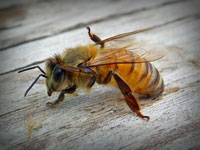Bees, Wasps, Hornets, Yellow Jackets |
 The warmer months are quickly approaching, and although there are many pleasantries that are associated with summer there are some aspects we'd rather forget. Along with the warmer weather come flying pests including bees, wasps, hornets, and yellow jackets. Bees while being helpful in gardening and farming for their pollinating abilities are generally thought of as a pest. Although honey bees are helpful in this manner not all bee species are as beneficial to humans. For instance, carpenter bees can cause severe damage to a home. If proper precautions are not taken, carpenter bees will bore holes into any type of untreated wood. This can include siding, decks, and any type of project comprised of unfinished wood left exposed. Although these holes can often be repaired by filling them with caulk, it is easily prevented by staining, varnishing, or even painting wood items. Wasps and bees are alike in the regard that they both have the ability to pollinate plants. In fact, wasps are often mistaken for bees for this reason. Wasps even tend to look somewhat like bees. However, unlike bees wasps tend to exhibit more aggressive behavior. In addition to being a more hostile type of flying pest, wasp nests tend to be a nuisance. Damage to wooden fences and structures can often be a sign of a wasp infestation. Wasps tend to build their nests in trees, under gutters, and beneath homes. Removing wasp nests can be a very dangerous task as aggravating a colony could lead to numerous wasp stings. Hornets are similar to wasps in the fact they tend to be more aggressive in nature. Often large wasps are referred to as hornets. Similar to wasps in the fact they build Mache like nests; hornets tend to use paper to construct their homes whereas wasps use wood particles. Like any variety of stinging insect hornet stings can be just as dangerous to those allergic to bee stings. Hornets also have a tendency to cause damage to trees and shrubs. Last but not least is the yellow jacket. Categorized in the same subfamily as wasps and hornets; yellow jackets get their name from their yellow bodies although some varieties are white and black. Similar in appearance to bees, yellow jackets are typically longer in length and again, more aggressive. In addition to feasting on the carcasses of various dead insects yellow jackets tend to be quite fond of people food, particularly food of a sweet variety. Sugar attracts yellow jackets making proper sanitation outdoors the best course of preventing them. Yellow jackets can cause structural damage to a home if they build nests within it. It is not uncommon for a yellow jacket colony to build a nest within a home's attic or garage. Bees, wasps, hornets, and yellow jackets can be beneficial to humans by pollinating our food supply and destroying insects that can harm it. However, as they are stinging insect species it is natural to want to keep them at bay. |
FREE QUOTE
Let's Get Started...
Save 20% By Scheduling Online...
Address
 Website Powered by BannerOS. Your Business Energized!
Website Powered by BannerOS. Your Business Energized!





